Cloud Solutions for My Health Record Project
VerifiedAdded on 2023/06/12
|11
|2539
|82
AI Summary
This report analyzes cloud solutions and their correlation with system development for the My Health Record project. It covers vendor solutions, strengths, weaknesses, and SDLC approaches. The report recommends an agile approach for the project and highlights the benefits of cloud computing.
Contribute Materials
Your contribution can guide someone’s learning journey. Share your
documents today.
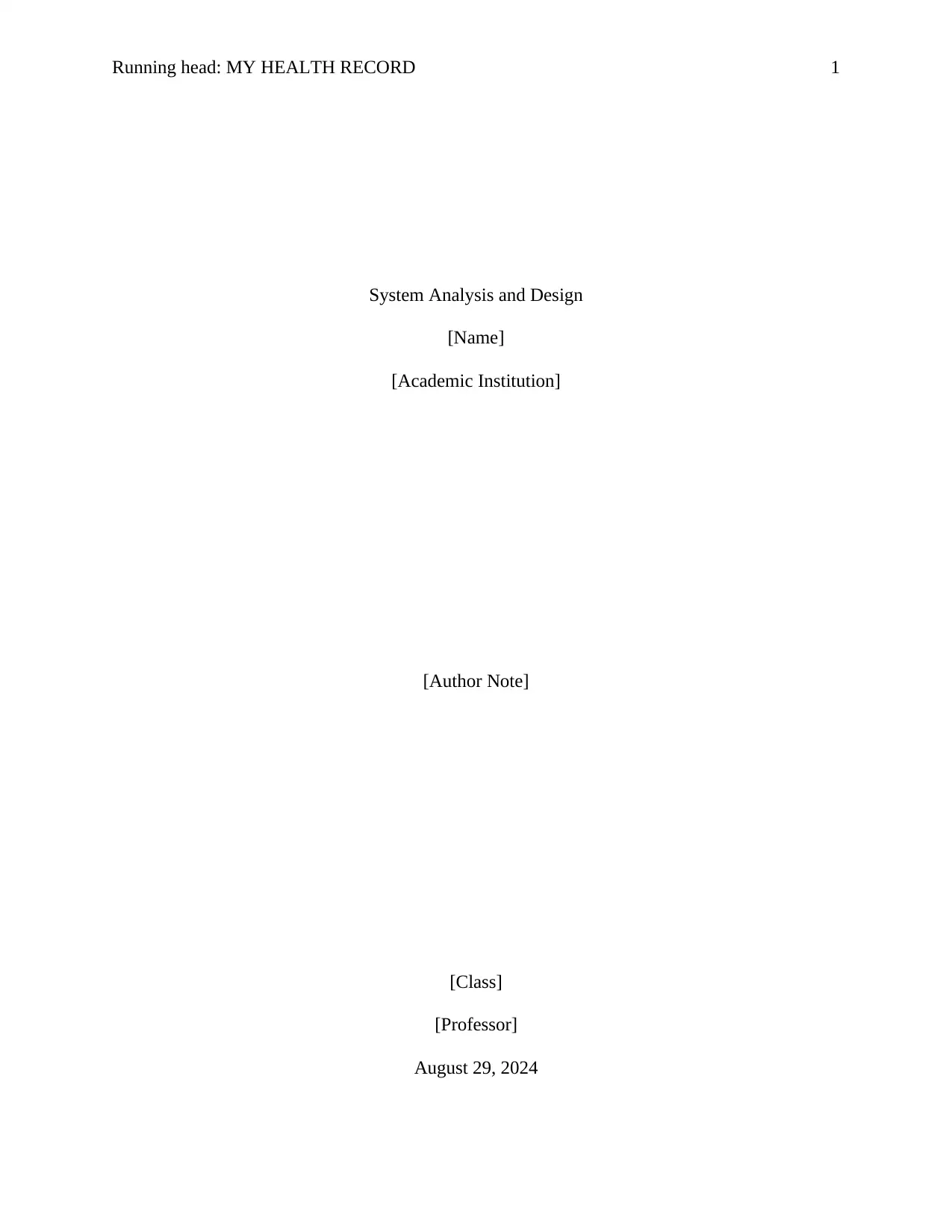
Running head: MY HEALTH RECORD 1
System Analysis and Design
[Name]
[Academic Institution]
[Author Note]
[Class]
[Professor]
August 29, 2024
System Analysis and Design
[Name]
[Academic Institution]
[Author Note]
[Class]
[Professor]
August 29, 2024
Secure Best Marks with AI Grader
Need help grading? Try our AI Grader for instant feedback on your assignments.
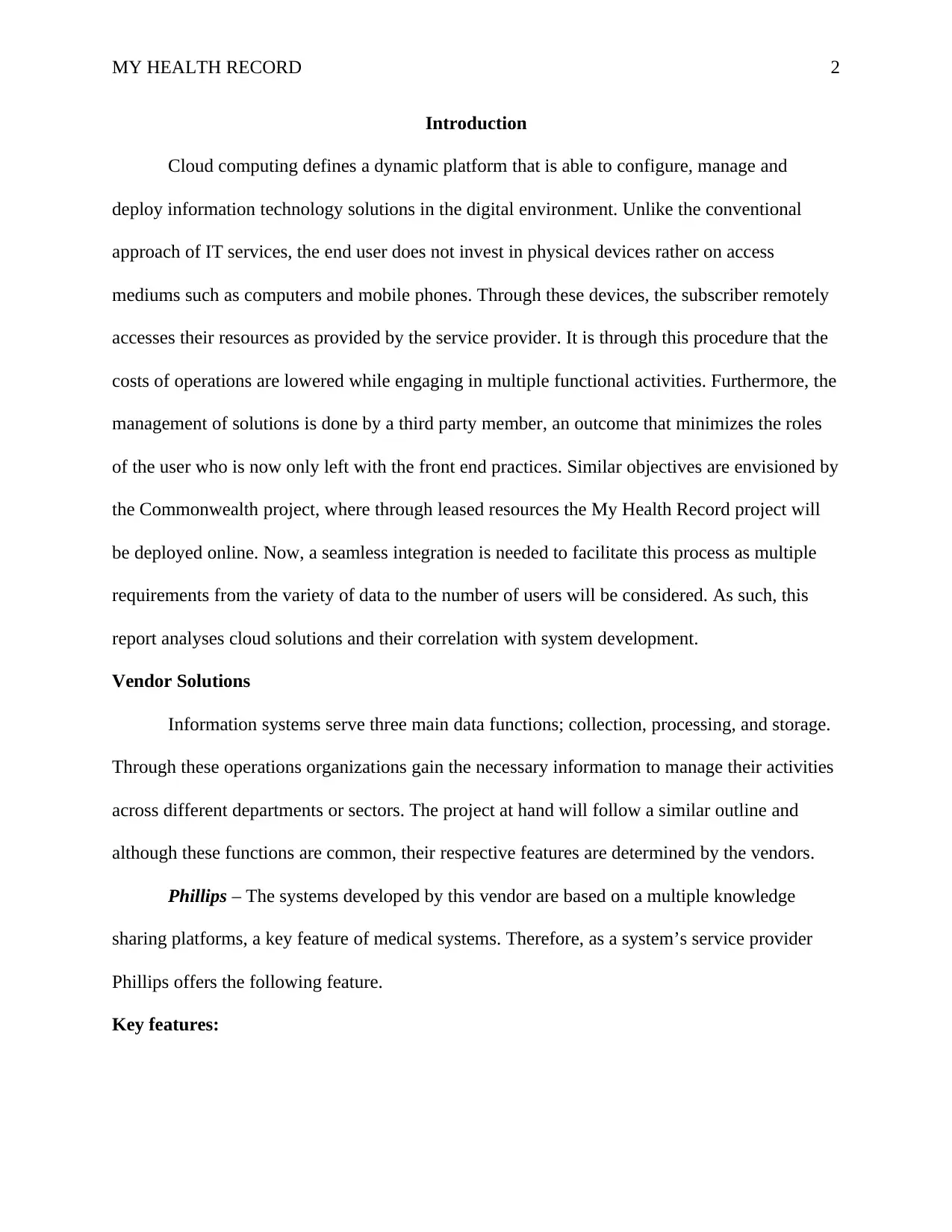
MY HEALTH RECORD 2
Introduction
Cloud computing defines a dynamic platform that is able to configure, manage and
deploy information technology solutions in the digital environment. Unlike the conventional
approach of IT services, the end user does not invest in physical devices rather on access
mediums such as computers and mobile phones. Through these devices, the subscriber remotely
accesses their resources as provided by the service provider. It is through this procedure that the
costs of operations are lowered while engaging in multiple functional activities. Furthermore, the
management of solutions is done by a third party member, an outcome that minimizes the roles
of the user who is now only left with the front end practices. Similar objectives are envisioned by
the Commonwealth project, where through leased resources the My Health Record project will
be deployed online. Now, a seamless integration is needed to facilitate this process as multiple
requirements from the variety of data to the number of users will be considered. As such, this
report analyses cloud solutions and their correlation with system development.
Vendor Solutions
Information systems serve three main data functions; collection, processing, and storage.
Through these operations organizations gain the necessary information to manage their activities
across different departments or sectors. The project at hand will follow a similar outline and
although these functions are common, their respective features are determined by the vendors.
Phillips – The systems developed by this vendor are based on a multiple knowledge
sharing platforms, a key feature of medical systems. Therefore, as a system’s service provider
Phillips offers the following feature.
Key features:
Introduction
Cloud computing defines a dynamic platform that is able to configure, manage and
deploy information technology solutions in the digital environment. Unlike the conventional
approach of IT services, the end user does not invest in physical devices rather on access
mediums such as computers and mobile phones. Through these devices, the subscriber remotely
accesses their resources as provided by the service provider. It is through this procedure that the
costs of operations are lowered while engaging in multiple functional activities. Furthermore, the
management of solutions is done by a third party member, an outcome that minimizes the roles
of the user who is now only left with the front end practices. Similar objectives are envisioned by
the Commonwealth project, where through leased resources the My Health Record project will
be deployed online. Now, a seamless integration is needed to facilitate this process as multiple
requirements from the variety of data to the number of users will be considered. As such, this
report analyses cloud solutions and their correlation with system development.
Vendor Solutions
Information systems serve three main data functions; collection, processing, and storage.
Through these operations organizations gain the necessary information to manage their activities
across different departments or sectors. The project at hand will follow a similar outline and
although these functions are common, their respective features are determined by the vendors.
Phillips – The systems developed by this vendor are based on a multiple knowledge
sharing platforms, a key feature of medical systems. Therefore, as a system’s service provider
Phillips offers the following feature.
Key features:
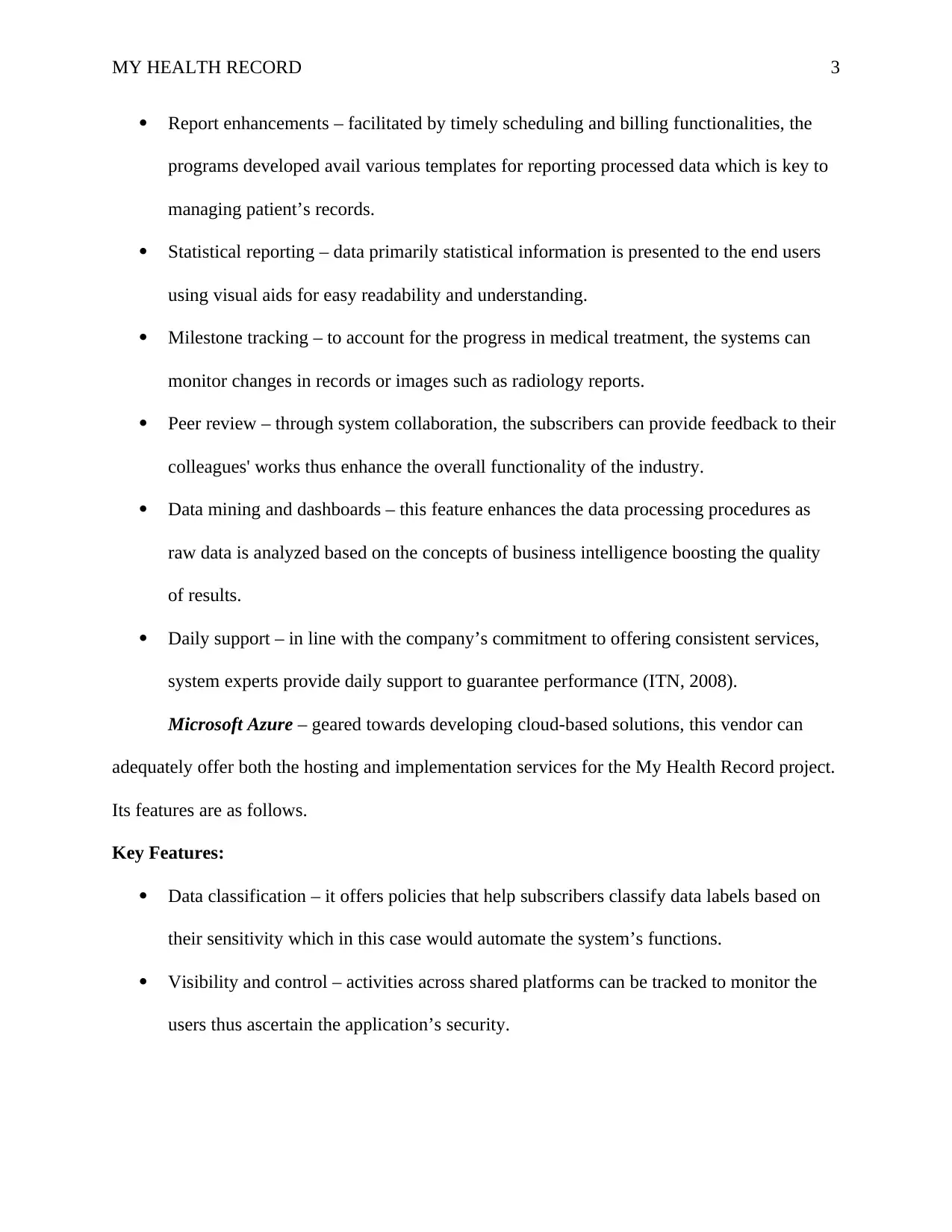
MY HEALTH RECORD 3
Report enhancements – facilitated by timely scheduling and billing functionalities, the
programs developed avail various templates for reporting processed data which is key to
managing patient’s records.
Statistical reporting – data primarily statistical information is presented to the end users
using visual aids for easy readability and understanding.
Milestone tracking – to account for the progress in medical treatment, the systems can
monitor changes in records or images such as radiology reports.
Peer review – through system collaboration, the subscribers can provide feedback to their
colleagues' works thus enhance the overall functionality of the industry.
Data mining and dashboards – this feature enhances the data processing procedures as
raw data is analyzed based on the concepts of business intelligence boosting the quality
of results.
Daily support – in line with the company’s commitment to offering consistent services,
system experts provide daily support to guarantee performance (ITN, 2008).
Microsoft Azure – geared towards developing cloud-based solutions, this vendor can
adequately offer both the hosting and implementation services for the My Health Record project.
Its features are as follows.
Key Features:
Data classification – it offers policies that help subscribers classify data labels based on
their sensitivity which in this case would automate the system’s functions.
Visibility and control – activities across shared platforms can be tracked to monitor the
users thus ascertain the application’s security.
Report enhancements – facilitated by timely scheduling and billing functionalities, the
programs developed avail various templates for reporting processed data which is key to
managing patient’s records.
Statistical reporting – data primarily statistical information is presented to the end users
using visual aids for easy readability and understanding.
Milestone tracking – to account for the progress in medical treatment, the systems can
monitor changes in records or images such as radiology reports.
Peer review – through system collaboration, the subscribers can provide feedback to their
colleagues' works thus enhance the overall functionality of the industry.
Data mining and dashboards – this feature enhances the data processing procedures as
raw data is analyzed based on the concepts of business intelligence boosting the quality
of results.
Daily support – in line with the company’s commitment to offering consistent services,
system experts provide daily support to guarantee performance (ITN, 2008).
Microsoft Azure – geared towards developing cloud-based solutions, this vendor can
adequately offer both the hosting and implementation services for the My Health Record project.
Its features are as follows.
Key Features:
Data classification – it offers policies that help subscribers classify data labels based on
their sensitivity which in this case would automate the system’s functions.
Visibility and control – activities across shared platforms can be tracked to monitor the
users thus ascertain the application’s security.
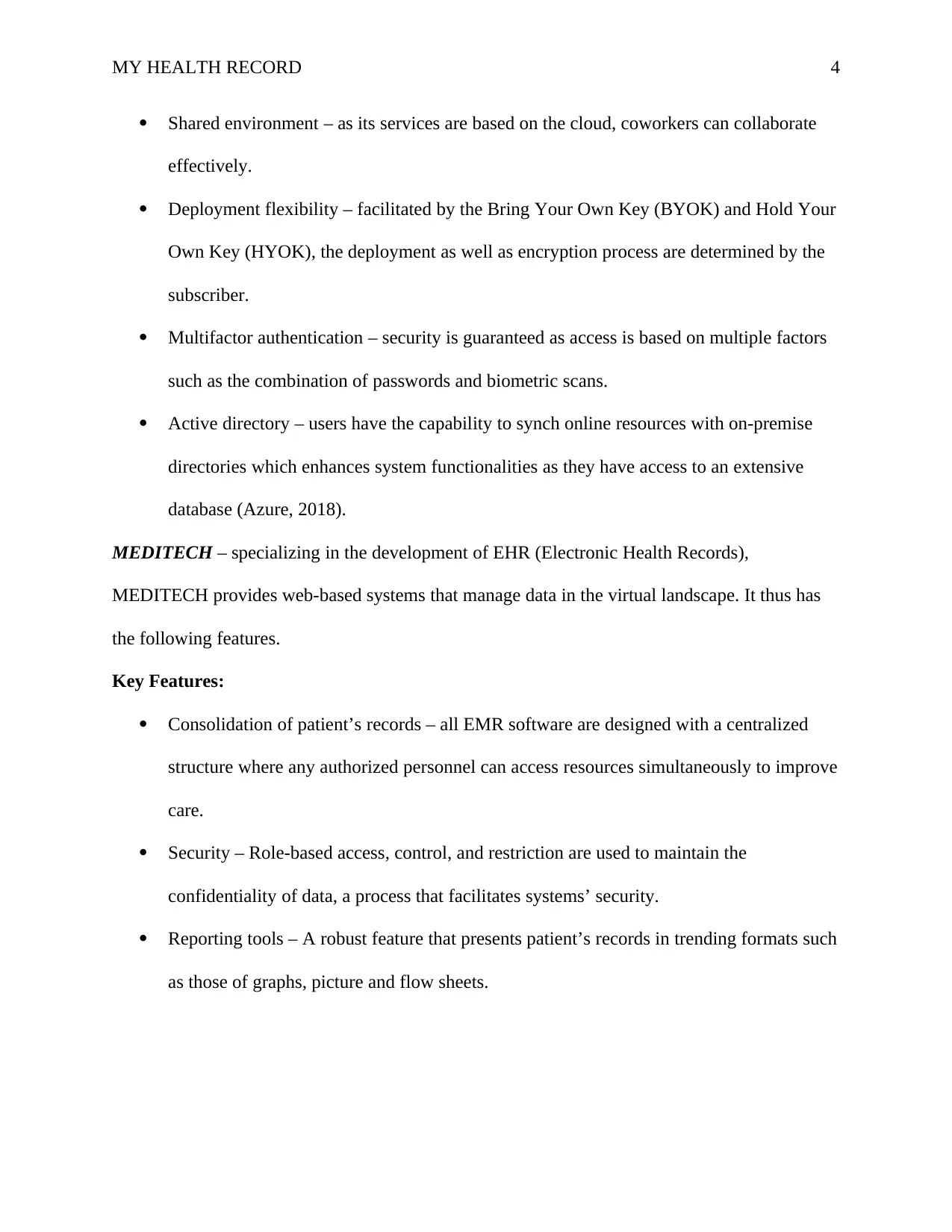
MY HEALTH RECORD 4
Shared environment – as its services are based on the cloud, coworkers can collaborate
effectively.
Deployment flexibility – facilitated by the Bring Your Own Key (BYOK) and Hold Your
Own Key (HYOK), the deployment as well as encryption process are determined by the
subscriber.
Multifactor authentication – security is guaranteed as access is based on multiple factors
such as the combination of passwords and biometric scans.
Active directory – users have the capability to synch online resources with on-premise
directories which enhances system functionalities as they have access to an extensive
database (Azure, 2018).
MEDITECH – specializing in the development of EHR (Electronic Health Records),
MEDITECH provides web-based systems that manage data in the virtual landscape. It thus has
the following features.
Key Features:
Consolidation of patient’s records – all EMR software are designed with a centralized
structure where any authorized personnel can access resources simultaneously to improve
care.
Security – Role-based access, control, and restriction are used to maintain the
confidentiality of data, a process that facilitates systems’ security.
Reporting tools – A robust feature that presents patient’s records in trending formats such
as those of graphs, picture and flow sheets.
Shared environment – as its services are based on the cloud, coworkers can collaborate
effectively.
Deployment flexibility – facilitated by the Bring Your Own Key (BYOK) and Hold Your
Own Key (HYOK), the deployment as well as encryption process are determined by the
subscriber.
Multifactor authentication – security is guaranteed as access is based on multiple factors
such as the combination of passwords and biometric scans.
Active directory – users have the capability to synch online resources with on-premise
directories which enhances system functionalities as they have access to an extensive
database (Azure, 2018).
MEDITECH – specializing in the development of EHR (Electronic Health Records),
MEDITECH provides web-based systems that manage data in the virtual landscape. It thus has
the following features.
Key Features:
Consolidation of patient’s records – all EMR software are designed with a centralized
structure where any authorized personnel can access resources simultaneously to improve
care.
Security – Role-based access, control, and restriction are used to maintain the
confidentiality of data, a process that facilitates systems’ security.
Reporting tools – A robust feature that presents patient’s records in trending formats such
as those of graphs, picture and flow sheets.
Secure Best Marks with AI Grader
Need help grading? Try our AI Grader for instant feedback on your assignments.
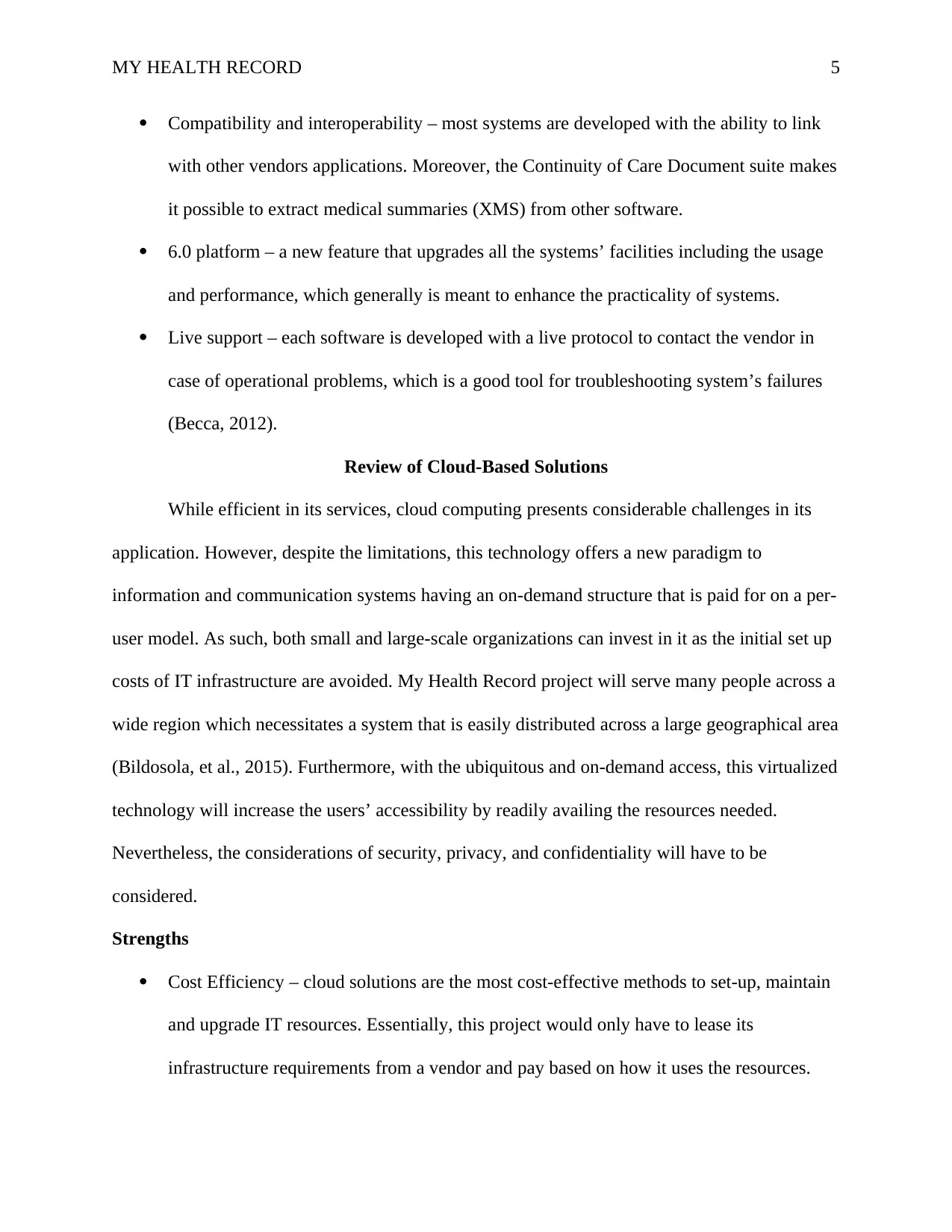
MY HEALTH RECORD 5
Compatibility and interoperability – most systems are developed with the ability to link
with other vendors applications. Moreover, the Continuity of Care Document suite makes
it possible to extract medical summaries (XMS) from other software.
6.0 platform – a new feature that upgrades all the systems’ facilities including the usage
and performance, which generally is meant to enhance the practicality of systems.
Live support – each software is developed with a live protocol to contact the vendor in
case of operational problems, which is a good tool for troubleshooting system’s failures
(Becca, 2012).
Review of Cloud-Based Solutions
While efficient in its services, cloud computing presents considerable challenges in its
application. However, despite the limitations, this technology offers a new paradigm to
information and communication systems having an on-demand structure that is paid for on a per-
user model. As such, both small and large-scale organizations can invest in it as the initial set up
costs of IT infrastructure are avoided. My Health Record project will serve many people across a
wide region which necessitates a system that is easily distributed across a large geographical area
(Bildosola, et al., 2015). Furthermore, with the ubiquitous and on-demand access, this virtualized
technology will increase the users’ accessibility by readily availing the resources needed.
Nevertheless, the considerations of security, privacy, and confidentiality will have to be
considered.
Strengths
Cost Efficiency – cloud solutions are the most cost-effective methods to set-up, maintain
and upgrade IT resources. Essentially, this project would only have to lease its
infrastructure requirements from a vendor and pay based on how it uses the resources.
Compatibility and interoperability – most systems are developed with the ability to link
with other vendors applications. Moreover, the Continuity of Care Document suite makes
it possible to extract medical summaries (XMS) from other software.
6.0 platform – a new feature that upgrades all the systems’ facilities including the usage
and performance, which generally is meant to enhance the practicality of systems.
Live support – each software is developed with a live protocol to contact the vendor in
case of operational problems, which is a good tool for troubleshooting system’s failures
(Becca, 2012).
Review of Cloud-Based Solutions
While efficient in its services, cloud computing presents considerable challenges in its
application. However, despite the limitations, this technology offers a new paradigm to
information and communication systems having an on-demand structure that is paid for on a per-
user model. As such, both small and large-scale organizations can invest in it as the initial set up
costs of IT infrastructure are avoided. My Health Record project will serve many people across a
wide region which necessitates a system that is easily distributed across a large geographical area
(Bildosola, et al., 2015). Furthermore, with the ubiquitous and on-demand access, this virtualized
technology will increase the users’ accessibility by readily availing the resources needed.
Nevertheless, the considerations of security, privacy, and confidentiality will have to be
considered.
Strengths
Cost Efficiency – cloud solutions are the most cost-effective methods to set-up, maintain
and upgrade IT resources. Essentially, this project would only have to lease its
infrastructure requirements from a vendor and pay based on how it uses the resources.

MY HEALTH RECORD 6
Unlimited Storage – the healthcare system will have huge storage requirement owing to
the number of users and size of data. This requirement is easily satisfied by cloud
solutions as vendors have endless storage facilities.
Easy access to Information – considering that access is done using web browsers, the
users (practitioners and patients) will easily access the system so long as they have an
internet connection.
Back-up and Recovery – in case of failure, the redundant resources used by the service
provider helps the subscriber recover their data (Apostu, et al., 2015).
Weaknesses
Data security – a serious vulnerability that is inherently caused by the technology’s
characteristics. For one, the subscriber (Commonwealth) has to surrender their data to a
third party member. Further, their resources are accessed via a public channel (the
internet).
Performance and outages – depending on the internet connection, the performance of the
online system will vary. Moreover, with the demands made by multiple customers, the
vendor’s resources may be overwhelmed resulting in outages.
High costs when attacked – although cloud resources are cheap to acquire, this benefit is
lost when the services are attacked by intruders. For instance, a Denial of Service (DoS)
attack can crash all servers resulting in huge losses, a cost that would increase even
further considering the user has to recover their data (HelpDesk LLC, 2011).
SDLC Approaches
Advances in information technology have resulted in complex systems that assist
organizations in their daily activities, from transactions to office automation. While traditional
Unlimited Storage – the healthcare system will have huge storage requirement owing to
the number of users and size of data. This requirement is easily satisfied by cloud
solutions as vendors have endless storage facilities.
Easy access to Information – considering that access is done using web browsers, the
users (practitioners and patients) will easily access the system so long as they have an
internet connection.
Back-up and Recovery – in case of failure, the redundant resources used by the service
provider helps the subscriber recover their data (Apostu, et al., 2015).
Weaknesses
Data security – a serious vulnerability that is inherently caused by the technology’s
characteristics. For one, the subscriber (Commonwealth) has to surrender their data to a
third party member. Further, their resources are accessed via a public channel (the
internet).
Performance and outages – depending on the internet connection, the performance of the
online system will vary. Moreover, with the demands made by multiple customers, the
vendor’s resources may be overwhelmed resulting in outages.
High costs when attacked – although cloud resources are cheap to acquire, this benefit is
lost when the services are attacked by intruders. For instance, a Denial of Service (DoS)
attack can crash all servers resulting in huge losses, a cost that would increase even
further considering the user has to recover their data (HelpDesk LLC, 2011).
SDLC Approaches
Advances in information technology have resulted in complex systems that assist
organizations in their daily activities, from transactions to office automation. While traditional
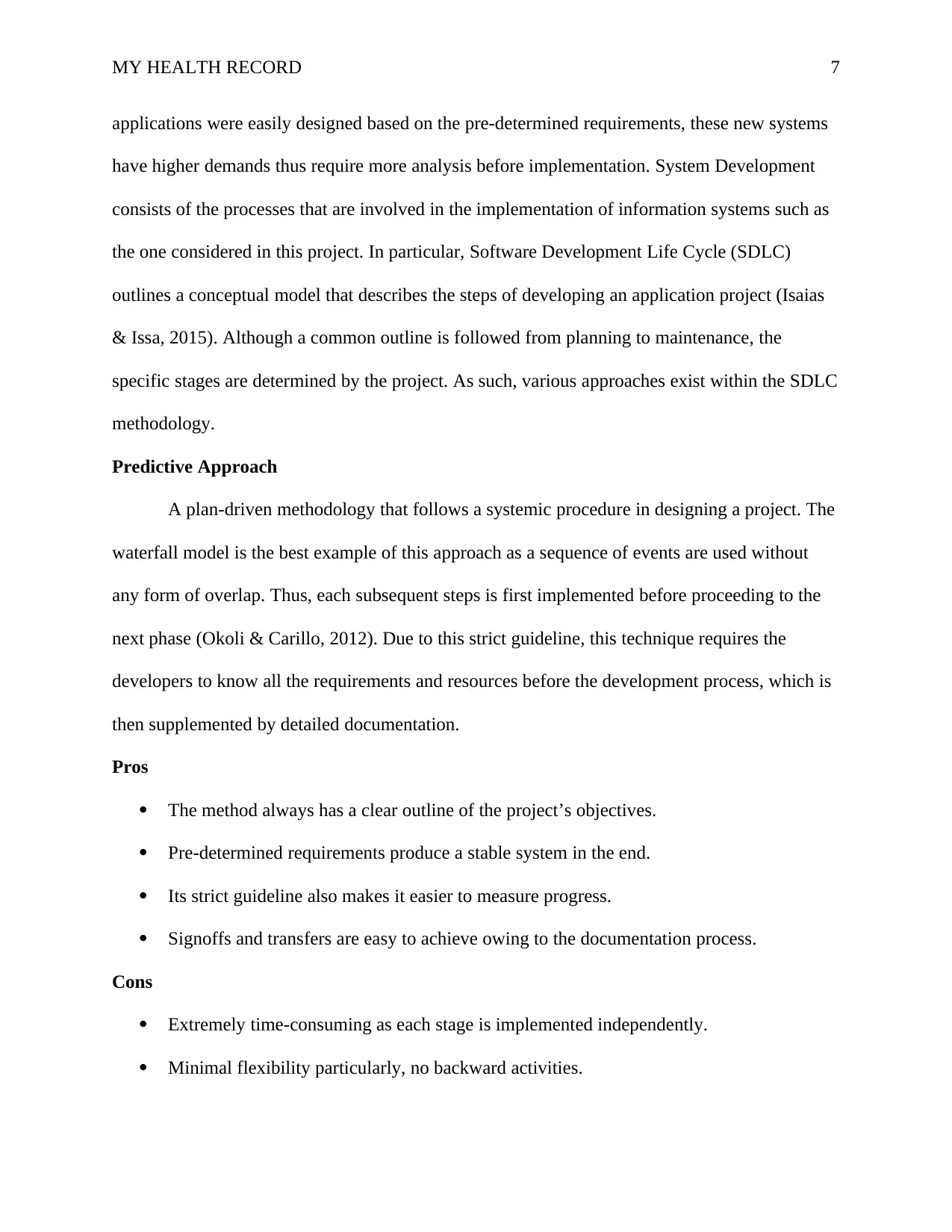
MY HEALTH RECORD 7
applications were easily designed based on the pre-determined requirements, these new systems
have higher demands thus require more analysis before implementation. System Development
consists of the processes that are involved in the implementation of information systems such as
the one considered in this project. In particular, Software Development Life Cycle (SDLC)
outlines a conceptual model that describes the steps of developing an application project (Isaias
& Issa, 2015). Although a common outline is followed from planning to maintenance, the
specific stages are determined by the project. As such, various approaches exist within the SDLC
methodology.
Predictive Approach
A plan-driven methodology that follows a systemic procedure in designing a project. The
waterfall model is the best example of this approach as a sequence of events are used without
any form of overlap. Thus, each subsequent steps is first implemented before proceeding to the
next phase (Okoli & Carillo, 2012). Due to this strict guideline, this technique requires the
developers to know all the requirements and resources before the development process, which is
then supplemented by detailed documentation.
Pros
The method always has a clear outline of the project’s objectives.
Pre-determined requirements produce a stable system in the end.
Its strict guideline also makes it easier to measure progress.
Signoffs and transfers are easy to achieve owing to the documentation process.
Cons
Extremely time-consuming as each stage is implemented independently.
Minimal flexibility particularly, no backward activities.
applications were easily designed based on the pre-determined requirements, these new systems
have higher demands thus require more analysis before implementation. System Development
consists of the processes that are involved in the implementation of information systems such as
the one considered in this project. In particular, Software Development Life Cycle (SDLC)
outlines a conceptual model that describes the steps of developing an application project (Isaias
& Issa, 2015). Although a common outline is followed from planning to maintenance, the
specific stages are determined by the project. As such, various approaches exist within the SDLC
methodology.
Predictive Approach
A plan-driven methodology that follows a systemic procedure in designing a project. The
waterfall model is the best example of this approach as a sequence of events are used without
any form of overlap. Thus, each subsequent steps is first implemented before proceeding to the
next phase (Okoli & Carillo, 2012). Due to this strict guideline, this technique requires the
developers to know all the requirements and resources before the development process, which is
then supplemented by detailed documentation.
Pros
The method always has a clear outline of the project’s objectives.
Pre-determined requirements produce a stable system in the end.
Its strict guideline also makes it easier to measure progress.
Signoffs and transfers are easy to achieve owing to the documentation process.
Cons
Extremely time-consuming as each stage is implemented independently.
Minimal flexibility particularly, no backward activities.
Paraphrase This Document
Need a fresh take? Get an instant paraphrase of this document with our AI Paraphraser
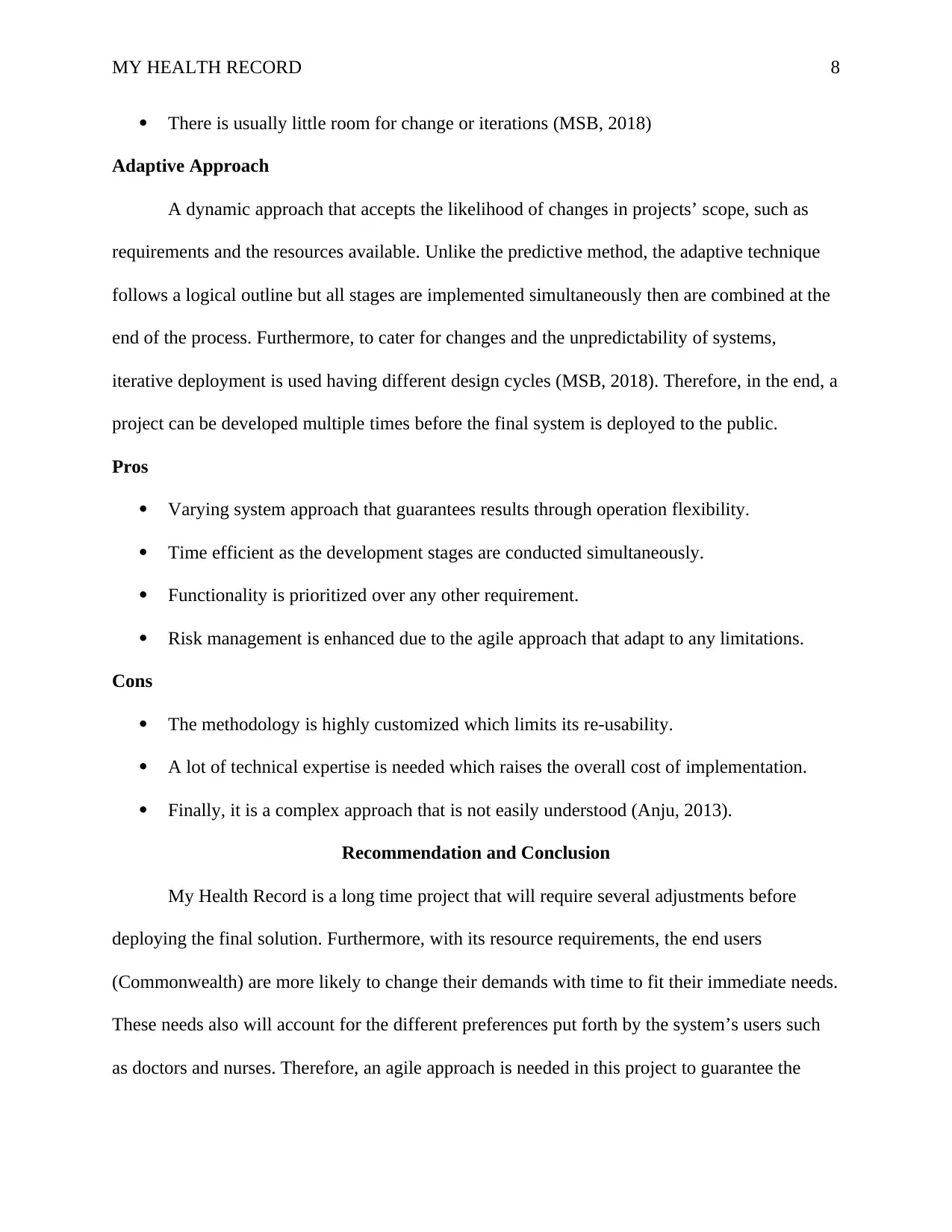
MY HEALTH RECORD 8
There is usually little room for change or iterations (MSB, 2018)
Adaptive Approach
A dynamic approach that accepts the likelihood of changes in projects’ scope, such as
requirements and the resources available. Unlike the predictive method, the adaptive technique
follows a logical outline but all stages are implemented simultaneously then are combined at the
end of the process. Furthermore, to cater for changes and the unpredictability of systems,
iterative deployment is used having different design cycles (MSB, 2018). Therefore, in the end, a
project can be developed multiple times before the final system is deployed to the public.
Pros
Varying system approach that guarantees results through operation flexibility.
Time efficient as the development stages are conducted simultaneously.
Functionality is prioritized over any other requirement.
Risk management is enhanced due to the agile approach that adapt to any limitations.
Cons
The methodology is highly customized which limits its re-usability.
A lot of technical expertise is needed which raises the overall cost of implementation.
Finally, it is a complex approach that is not easily understood (Anju, 2013).
Recommendation and Conclusion
My Health Record is a long time project that will require several adjustments before
deploying the final solution. Furthermore, with its resource requirements, the end users
(Commonwealth) are more likely to change their demands with time to fit their immediate needs.
These needs also will account for the different preferences put forth by the system’s users such
as doctors and nurses. Therefore, an agile approach is needed in this project to guarantee the
There is usually little room for change or iterations (MSB, 2018)
Adaptive Approach
A dynamic approach that accepts the likelihood of changes in projects’ scope, such as
requirements and the resources available. Unlike the predictive method, the adaptive technique
follows a logical outline but all stages are implemented simultaneously then are combined at the
end of the process. Furthermore, to cater for changes and the unpredictability of systems,
iterative deployment is used having different design cycles (MSB, 2018). Therefore, in the end, a
project can be developed multiple times before the final system is deployed to the public.
Pros
Varying system approach that guarantees results through operation flexibility.
Time efficient as the development stages are conducted simultaneously.
Functionality is prioritized over any other requirement.
Risk management is enhanced due to the agile approach that adapt to any limitations.
Cons
The methodology is highly customized which limits its re-usability.
A lot of technical expertise is needed which raises the overall cost of implementation.
Finally, it is a complex approach that is not easily understood (Anju, 2013).
Recommendation and Conclusion
My Health Record is a long time project that will require several adjustments before
deploying the final solution. Furthermore, with its resource requirements, the end users
(Commonwealth) are more likely to change their demands with time to fit their immediate needs.
These needs also will account for the different preferences put forth by the system’s users such
as doctors and nurses. Therefore, an agile approach is needed in this project to guarantee the
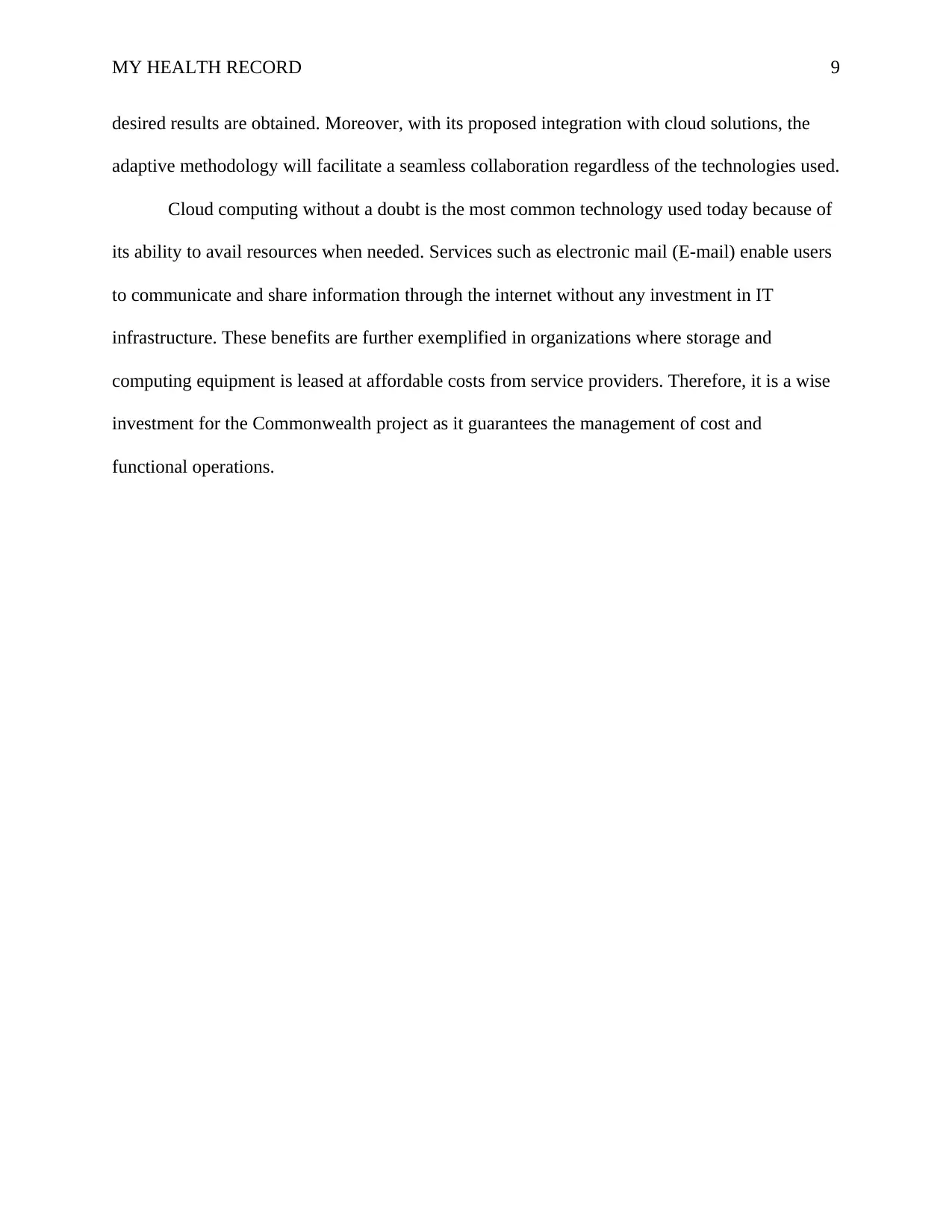
MY HEALTH RECORD 9
desired results are obtained. Moreover, with its proposed integration with cloud solutions, the
adaptive methodology will facilitate a seamless collaboration regardless of the technologies used.
Cloud computing without a doubt is the most common technology used today because of
its ability to avail resources when needed. Services such as electronic mail (E-mail) enable users
to communicate and share information through the internet without any investment in IT
infrastructure. These benefits are further exemplified in organizations where storage and
computing equipment is leased at affordable costs from service providers. Therefore, it is a wise
investment for the Commonwealth project as it guarantees the management of cost and
functional operations.
desired results are obtained. Moreover, with its proposed integration with cloud solutions, the
adaptive methodology will facilitate a seamless collaboration regardless of the technologies used.
Cloud computing without a doubt is the most common technology used today because of
its ability to avail resources when needed. Services such as electronic mail (E-mail) enable users
to communicate and share information through the internet without any investment in IT
infrastructure. These benefits are further exemplified in organizations where storage and
computing equipment is leased at affordable costs from service providers. Therefore, it is a wise
investment for the Commonwealth project as it guarantees the management of cost and
functional operations.
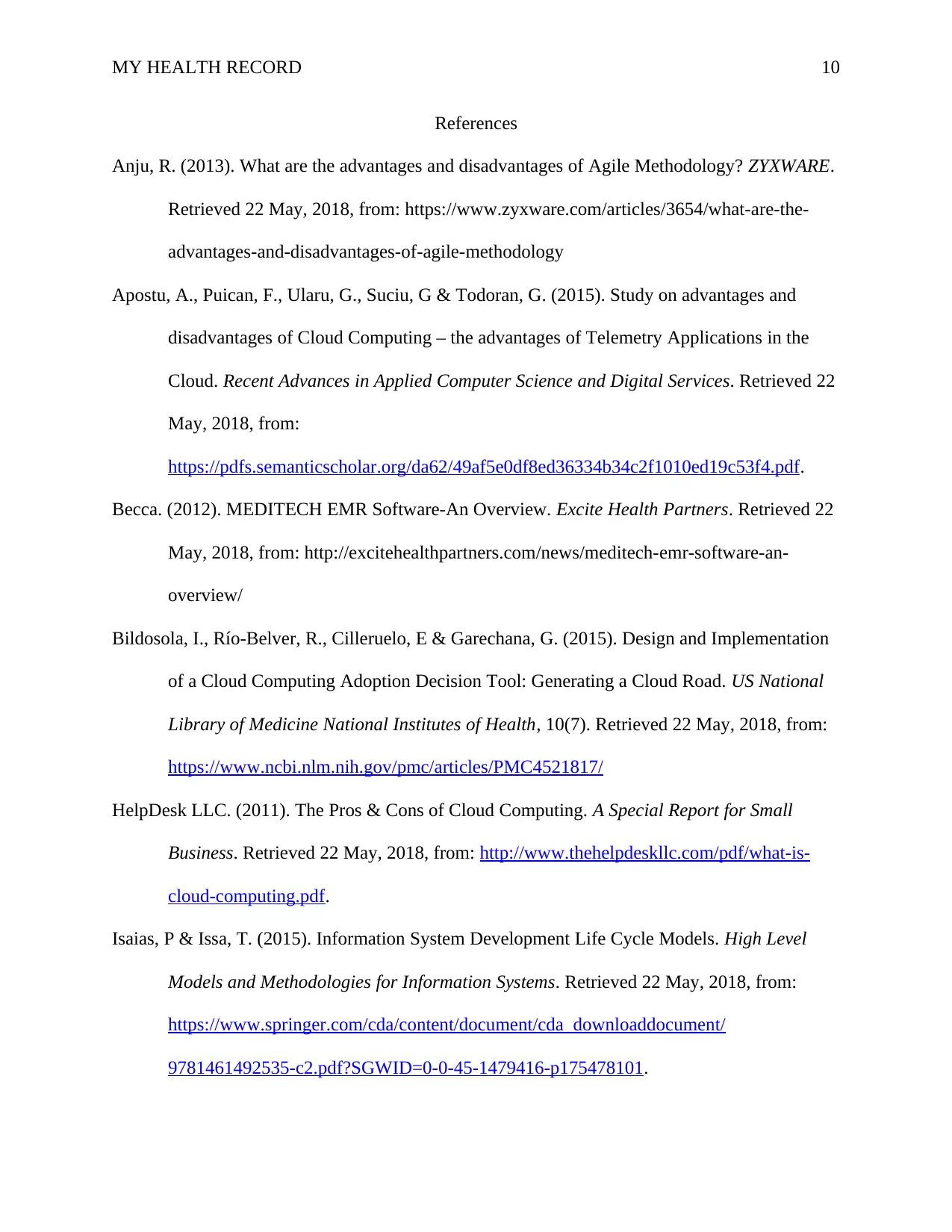
MY HEALTH RECORD 10
References
Anju, R. (2013). What are the advantages and disadvantages of Agile Methodology? ZYXWARE.
Retrieved 22 May, 2018, from: https://www.zyxware.com/articles/3654/what-are-the-
advantages-and-disadvantages-of-agile-methodology
Apostu, A., Puican, F., Ularu, G., Suciu, G & Todoran, G. (2015). Study on advantages and
disadvantages of Cloud Computing – the advantages of Telemetry Applications in the
Cloud. Recent Advances in Applied Computer Science and Digital Services. Retrieved 22
May, 2018, from:
https://pdfs.semanticscholar.org/da62/49af5e0df8ed36334b34c2f1010ed19c53f4.pdf.
Becca. (2012). MEDITECH EMR Software-An Overview. Excite Health Partners. Retrieved 22
May, 2018, from: http://excitehealthpartners.com/news/meditech-emr-software-an-
overview/
Bildosola, I., Río-Belver, R., Cilleruelo, E & Garechana, G. (2015). Design and Implementation
of a Cloud Computing Adoption Decision Tool: Generating a Cloud Road. US National
Library of Medicine National Institutes of Health, 10(7). Retrieved 22 May, 2018, from:
https://www.ncbi.nlm.nih.gov/pmc/articles/PMC4521817/
HelpDesk LLC. (2011). The Pros & Cons of Cloud Computing. A Special Report for Small
Business. Retrieved 22 May, 2018, from: http://www.thehelpdeskllc.com/pdf/what-is-
cloud-computing.pdf.
Isaias, P & Issa, T. (2015). Information System Development Life Cycle Models. High Level
Models and Methodologies for Information Systems. Retrieved 22 May, 2018, from:
https://www.springer.com/cda/content/document/cda_downloaddocument/
9781461492535-c2.pdf?SGWID=0-0-45-1479416-p175478101.
References
Anju, R. (2013). What are the advantages and disadvantages of Agile Methodology? ZYXWARE.
Retrieved 22 May, 2018, from: https://www.zyxware.com/articles/3654/what-are-the-
advantages-and-disadvantages-of-agile-methodology
Apostu, A., Puican, F., Ularu, G., Suciu, G & Todoran, G. (2015). Study on advantages and
disadvantages of Cloud Computing – the advantages of Telemetry Applications in the
Cloud. Recent Advances in Applied Computer Science and Digital Services. Retrieved 22
May, 2018, from:
https://pdfs.semanticscholar.org/da62/49af5e0df8ed36334b34c2f1010ed19c53f4.pdf.
Becca. (2012). MEDITECH EMR Software-An Overview. Excite Health Partners. Retrieved 22
May, 2018, from: http://excitehealthpartners.com/news/meditech-emr-software-an-
overview/
Bildosola, I., Río-Belver, R., Cilleruelo, E & Garechana, G. (2015). Design and Implementation
of a Cloud Computing Adoption Decision Tool: Generating a Cloud Road. US National
Library of Medicine National Institutes of Health, 10(7). Retrieved 22 May, 2018, from:
https://www.ncbi.nlm.nih.gov/pmc/articles/PMC4521817/
HelpDesk LLC. (2011). The Pros & Cons of Cloud Computing. A Special Report for Small
Business. Retrieved 22 May, 2018, from: http://www.thehelpdeskllc.com/pdf/what-is-
cloud-computing.pdf.
Isaias, P & Issa, T. (2015). Information System Development Life Cycle Models. High Level
Models and Methodologies for Information Systems. Retrieved 22 May, 2018, from:
https://www.springer.com/cda/content/document/cda_downloaddocument/
9781461492535-c2.pdf?SGWID=0-0-45-1479416-p175478101.
Secure Best Marks with AI Grader
Need help grading? Try our AI Grader for instant feedback on your assignments.
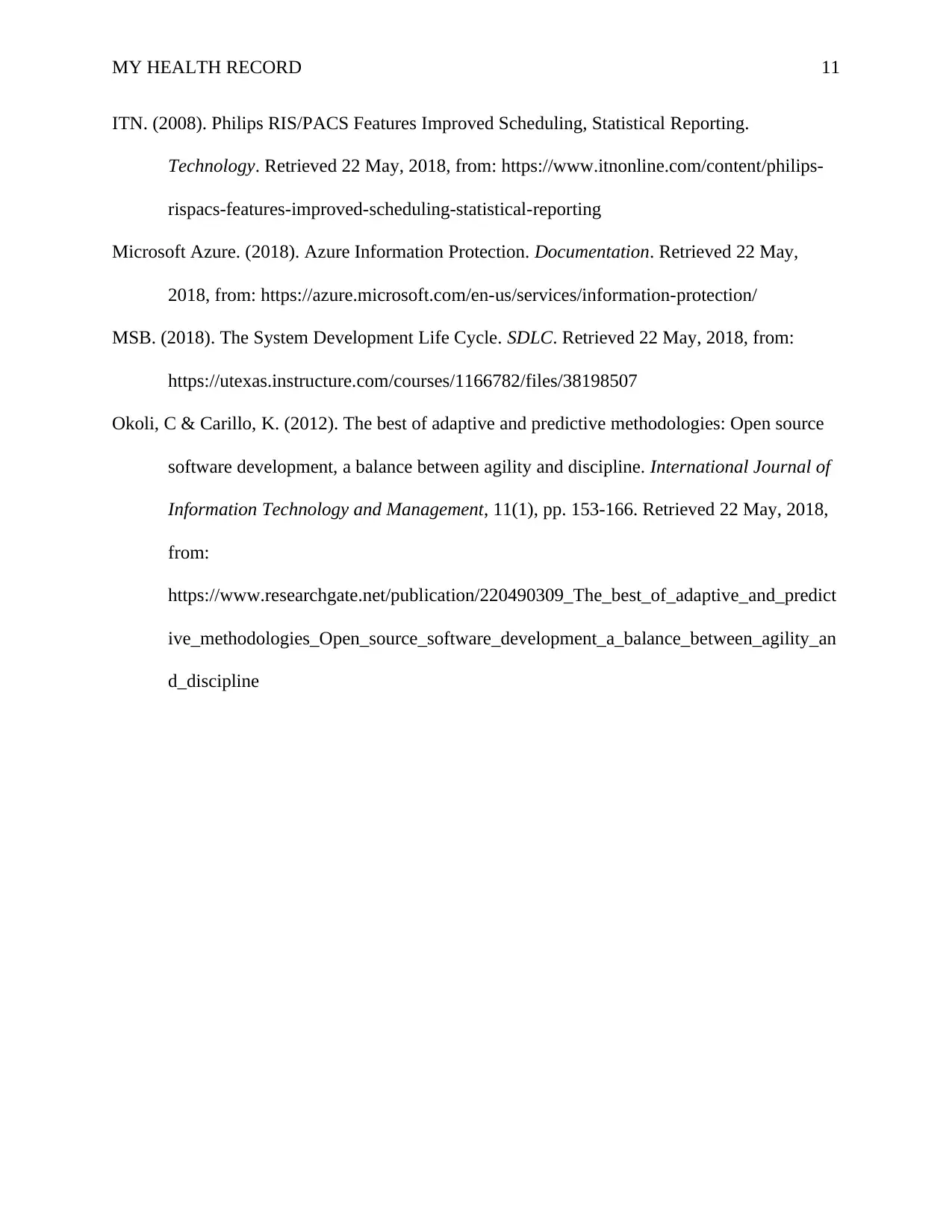
MY HEALTH RECORD 11
ITN. (2008). Philips RIS/PACS Features Improved Scheduling, Statistical Reporting.
Technology. Retrieved 22 May, 2018, from: https://www.itnonline.com/content/philips-
rispacs-features-improved-scheduling-statistical-reporting
Microsoft Azure. (2018). Azure Information Protection. Documentation. Retrieved 22 May,
2018, from: https://azure.microsoft.com/en-us/services/information-protection/
MSB. (2018). The System Development Life Cycle. SDLC. Retrieved 22 May, 2018, from:
https://utexas.instructure.com/courses/1166782/files/38198507
Okoli, C & Carillo, K. (2012). The best of adaptive and predictive methodologies: Open source
software development, a balance between agility and discipline. International Journal of
Information Technology and Management, 11(1), pp. 153-166. Retrieved 22 May, 2018,
from:
https://www.researchgate.net/publication/220490309_The_best_of_adaptive_and_predict
ive_methodologies_Open_source_software_development_a_balance_between_agility_an
d_discipline
ITN. (2008). Philips RIS/PACS Features Improved Scheduling, Statistical Reporting.
Technology. Retrieved 22 May, 2018, from: https://www.itnonline.com/content/philips-
rispacs-features-improved-scheduling-statistical-reporting
Microsoft Azure. (2018). Azure Information Protection. Documentation. Retrieved 22 May,
2018, from: https://azure.microsoft.com/en-us/services/information-protection/
MSB. (2018). The System Development Life Cycle. SDLC. Retrieved 22 May, 2018, from:
https://utexas.instructure.com/courses/1166782/files/38198507
Okoli, C & Carillo, K. (2012). The best of adaptive and predictive methodologies: Open source
software development, a balance between agility and discipline. International Journal of
Information Technology and Management, 11(1), pp. 153-166. Retrieved 22 May, 2018,
from:
https://www.researchgate.net/publication/220490309_The_best_of_adaptive_and_predict
ive_methodologies_Open_source_software_development_a_balance_between_agility_an
d_discipline
1 out of 11
Related Documents
Your All-in-One AI-Powered Toolkit for Academic Success.
+13062052269
info@desklib.com
Available 24*7 on WhatsApp / Email
![[object Object]](/_next/static/media/star-bottom.7253800d.svg)
Unlock your academic potential
© 2024 | Zucol Services PVT LTD | All rights reserved.




